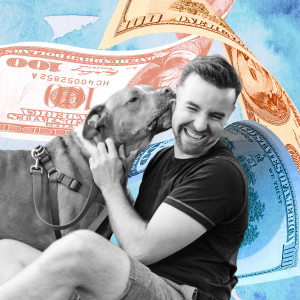How Much Will Your Dog Cost You in a Lifetime?
Our best friends are worth their weight in gold. But—it’s no big deal, just wondering—how much gold, exactly?

Share Article
Most dog parents know one thing: Out of all the pups in the world, they have the best one(s). They also know that their dog is perfect in every way except for maybe one: They cost money. Sometimes, a lot of it.
There’s a ton of variety depending on what type of dog you have and their specific needs, how they’re cared for, and where they live. A recent studyopens in new tab by Synchrony, a financial services company, put the estimate somewhere between $20,000 and $55,000 — a huge range.
Zach Novak, a certified financial planner at Facetopens in new tab, the flat-fee, full service financial planning company, is a dog parent himself. Because there’s so much variability when it comes to costs of pet goods and services, Novak recommends that, prior to moving forward with adoption, his clients envision the dog they’ll have and their lifestyle, so they can come up “with a number that everybody is comfortable with.”
“What is her training plan and how much is this going to cost? 1:1 Training, board and train, on our own?” is an example of a question that he’d ask his client ahead of time. Big? Small? Just right? Large dogs tend to have more health problems and shorter lifespans. Also: “Do we want to consider a dog walker or doggie daycare as a result of working full time and if so, how much would that cost?” (A lot, FYI.)
Once his clients have a sense of the lifestyle costs, they can “tally up all of these expenses both upfront and ongoing, put them on paper, assess our overarching comfort level with them and how they fit into our budget, and use these numbers to influence some of our financial decisions.”
We’ve attempted to work through Novak’s exercise using a dog we made up as an example. Her name is Ruby, and she’s a 40-pound rescue Australian Cattle Dog who lives in Denver, a dog-friendly, mid-sized city that has seasons. She lived 14 years, smack in the middle of the 12-to-16 year average lifespanopens in new tab for her size and breed.
Her long life (and all the costs that apply), is just one possible roadmap. Hopefully, her example can be a useful tool for your own preparations prior to adopting or during pet parenthood.
First two years: $5,585
The startup cost of a dog will likely be your biggest investment in the pup’s lifetime, especially if they remain healthy otherwise. The good news is that with a lot of these items, it’s just one and done.
There are core vaccines that are required for all dogs, and then there are highly recommended vaccines and medications based on living conditions. “Rabies is always going to be core. Most cities and counties require it,” veterinarian Dr. Jessica Apted, medical director at Sploot Vetinary Careopens in new tab, says. “But then if you look at a vaccine like Bordetella, the kennel cough vaccine, that can be something that we talk more about.”
Ruby not only got the kennel cough vaccine, but also vaccines and boosters for Lyme and rattlesnakes.
Another thing Dr. Apted strongly recommends at the puppy stage is going all in on behavioral training. She highly recommends sleep-away training, where a dog lives with a trainer for a month when they are small, though this can cost around $2,000 or more. Other foundation classes will prove useful as well. In our example, Ruby’s parents bought a four-week group training package — a much cheaper, but less comprehensive option.
“Spending the money [on training] when they’re a puppy is one of the biggest things I can push for because then you just have no issues,” Dr. Apted says. “Over a lifetime, it can be much more—thousands and thousands and thousands of dollars — that you’re spending on medications or certified specialized behavior visits and more trainers.”
Now, some numbers:
One-off expenses
Adoption fee: $282
Vaccine, testing, microchip package: $208
Spay: $219
Puppy classes: $209
Crate: $76.02
Bed: $90
Slow feeder: $13.99
Leash: $26.64
Collar: $22.46
Harness: $29.01
Brush: $14.19
Nail clipper: $11.19
Paw protection: $49.64
Car seat: $67.58
Puzzle: $16.41
Pee pads: $44.50
Portable water bottle: $7.39
Pet Cam: $34.99
Total one-off expense: $1,422
Annual
Routine vet: $68.21
Heartworm/Flea/Tick: $362
Boosters: $150.00
Food: $668.52
Dog sitter (five days): $373
Toys and treats*: $300
Bully sticks/other chews: $122.96
Cleaning spray: $7.77
Toothbrush: $10.26
Poop bags: $18.63
Total annual expenses: $2,081.35
Total annuals over two years: $4,162.27
Grand total (one-offs and annuals x2): $5,584.27
* The “toys and treats” category is based on the average of three monthly subscription boxes that include both items.
Two to five years old: $6,086
These years are all about maintenance.
Heartworm/Flea/Tick: $362
Food: $668.52
Dog sitter (five days)$373
Toys and treats*: $300
Bully sticks/bones: $122.96
Cleaning spray: $7.77
Toothbrush: $10.26
Poop bags: $18.63
New bed: $26.64
Vet visit: $58.95
Boosters: $80
Total: $2,028.73
Total over three years: $6,086.19
Five to eight years old: $6,346.85
Ruby remained healthy through these years, save one issue. Thanks to her active lifestyle, Ruby did what a lot of dogs do: She split a nail. This can be dangerous for dogs and can require vet care. Often, because the nail bed has more nerves and blood vessels, this trip to the vet involves sedation, which costs extra.
We’ve also had Ruby’s parent’s replace some of their pet supplies, like their leash and harness, due to wear and tear.
One-off expense
Nail repair: $241.67
Annual
Heartworm/Flea/Tick: $362
Food: $668.52
Dog sitter (5 days): $373
Toys and treats*: $300
Cleaning spray: $7.77
Toothbrush: $10.26
Ear cleaner: $18.05
Poop bags: $18.63
New Leash: $22.46
New Harness: $29.01
New Puzzle: $16.41
Boosters: $150.00
Vet visit: $58.95
Total: $2,035.06
Total over three years: $6,105.18
Total over three years + one-off: $6,346.85
Eight to 11 years old: $6,440.10
Ruby began to show signs of joint pain at eight years of age. Her vet recommended a prescription diet and vitamins. Her parents updated her leash and harness again and replaced her bed.
Heartworm/Flea/Tick: $362
Food: $668.52
Dog sitter (five days): $373
Toys and treats: $300
Cleaning spray: $7.77
Toothbrush: $10.26
Poop bags: $18.63
New Bed: $26.64
New Leash: $22.46
New Harness: $29.01
New Puzzle: $16.41
Vitamins: $155
Ear cleaner: $18.05
Vet visit: $58.95
Boosters: $80
Total: $2,146.70
Total over three years: $6,440.10
11 to 14 years old: $11,221.25
Novak, CFP, recommends having an emergency fund for surprise expenses over the entirety of the dog’s life. (And if you spoke with Dr. Apted, you’d understand why having one for pup’s early life, not just for ailments that have to do with aging. Ask her about the Golden Retriever who swallowed a kitchen knife). The end-of-life care, however, is where he’s seen the cost domino.
“It varies so much depending on geographic location, what kind of dog it is. Is it a younger dog where [an emergency] would be more of an accident or is it an older dog that’s starting to have some health issues?” Novak says. “We'll just try to come up with a number that everybody can agree with, usually between maybe $5,000 and $10,000.”
But, Novak adds, this fund can also be used for something fun. “Like if you were going to go on a vacation, and you’d have to potentially board the dog for a week or something like that,” he says. “It would be nice to have a little extra stashed away for a weeklong dog vacation.”
The biggest surprise costs Dr. Apted sees later in life are dental issues and diabetes, for which some breeds are more genetically predisposed than others and can cost an extra $2,500 a yearopens in new tab. Though a number of issues can arise over a dog’s lifetime, our couple’s big one is when they decided to get Ruby a Femoral Head Ostectomy on both legs. This kind of joint issue is common in Australian Cattle Dogs, and according to Lemonade insuranceopens in new tab, the surgery can cost “between $1,200 to $2,500 or more per hip, which would include pre-surgical bloodwork, anesthesia, the surgery, and post-surgical care and medications.”
It’s no fun to think about, and of course you can’t predict this part when you adopt, but we’ve also included estimates for Ruby’s end-of-life. Derek and Amanda decided to put their pup down at 14 under the advice of their vet and have her communally cremated (private cremation tends to cost more). Thankfully, Ruby lived a good, long, and largely healthy life, full of outdoor adventures, and never swallowed anything she shouldn’t have.
One-off expenses
FHO surgery x2: $5,000
Euthanasia and cremation: $120
Annual expenses
Heartworm/Flea/Tick: $362
Routine check-up: $68.21
Food: $668.52
Dog sitter (5 days): $373
Toys and treats: $300
Cleaning spray: $7.77
Toothbrush: $10.26
Poop bags: $18.63
Boosters: $150.00
New Puzzle: $16.41
Vet visit: $58.95
Total: $2,033.75
Total over three years: $6,101.25
Total over three years + one-off: $11,221.25
Grand total estimate for Ruby over a lifetime: $35,679.20
So Ruby cost about $36,000 over her lifetime. The calculations we’ve made for physical items do not include shipping and tax, and every dog has their own challenges in their lifetime, be it medical or behavioral, or both. While you can know the potential risks of different breeds and their early experiences, you can’t always anticipate what surprises they have in store.
How to cut costs where you can
Dr. Apted, who raises dogs herself, has some cost-saving tips at the ready. She notes that pet parents are paying for convenience if they pick up their flea and tick at the vet appointment, but websites like Chewy opens in new tab offer these medications for less (in our calculations we used bulk ordering from national e-commerce sites). Ditto vaccines and spay/neutering. Some vaccine clinics, or shelters and rescues will have spay appointments and vaccine days for less.
At Sploot Vets and others, another expense-mitigation tactic is having a nurse administer vaccines rather than a doctor. Dr. Apted also mentioned CareCreditopens in new tab, a deferred payment card that can be used to pay for upfront pet care costs like vet visits.
Caveats, clauses, and methods
Here are some things to keep in mind about the numbers above. Rescuing a puppy, rather than an older dog, means that pet parents may be responsible for neutering or spay appointments, plus most rounds of vaccinations. However, insurance premiumsopens in new tab are generally cheaper the younger your dog is (more on that later).
Some notes on my method: When it comes to physical items like a crate or collar, we’ve collected three price tags and averaged them. These items come from online vendors that ship everywhere in the U.S. — like Chewy, Amazon, Petco, and Petsmart — and do not include shipping or tax. For services like adoption fees or boarding, the three averaged quotes come from businesses in the Denver area with prices listed on their website. Although there’s a note on the annual cost of pet insurance at the end, the numbers provided do not include insurance premiums, and all costs shown are out-of-pocket.
Something else to consider is that, where applicable, all of the items selected are sized for medium breeds, like Ruby. The canine world lives by Goldilocks Rules. Stuff for big dogs tends to cost more, and stuff for small dogs tends to cost less, and then there’s the middle.
And one final note: There is no ceiling to how much you can spend on your dog. The three items or services chosen and averaged aren’t necessarily the top of the line, but are in more affordable ranges. Perhaps it’s comforting to know that however much you are spending on your dog in its lifetime, you can always, always be spending more.

Kenzie Bryant
Kenzie Bryant is a freelance writer who lives in Brooklyn with her dog, Bonnie. Her work has been featured in Vanity Fair and Racked.
Related articles
![Smiling woman happy at the animal clinic with the veterinarian.]()
How Much Does a Vet Visit Cost? Average Cost in 2025
Don’t get freaked out by the cost of pet parenthood—get prepared.
![Young beautiful woman cuddling with little snow bengal kitten on the bed.]()
15 Terms You Should Know When Choosing a Pet Insurance Plan
Overwhelmed by all the small print and jargon? We’ve got you.
![Dalmatian mix breed dog is playing with a dog toy on a soft surface]()
Digging into the Fine Print of Pet Insurance
Everything you need to know to understand pet insurance plans.
![A woman in a bright yellow-orange sweater holding a striped kitten in one hand and a credit card in the other while using her laptop in front of her]()
How to Get Help With Vet Bills for Dogs Who Need Surgery
Worried about the cost of making your pet feel better? Help is on the way.
![shiba inu snuggling on couch with woman]()
Money Talks: The Dollars of Dog Parenthood
We crunched some numbers and yup, they’re worth every penny.
![A woman in a yellow sweater and jeans sitting and petting the head of her gray cat eating dry food from the floor in her kitchen]()
How to Find Free Pet Food Near You
These community resources can help your pet get the food they need.












